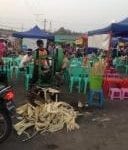Written by Thu Tran, MD,FACOG
May 1, 2014
Monday morning in the clinic was not productive for me because I didn’t have too many patients to see. It turned out that many of them had heard of our arrival the day before and wanted to come to the clinic on the first day. We saw similar problems to those we had seen the day before, mostly infertility and “white discharge.” Noel could have seen these patients alone. By midmorning, we were done with our patients and asked the medical officer to give us a tour of Labor and Delivery Suite.
As we walked across the courtyard to the hospital, however, we were informed by the senior attending whom we met the day before that we were not permitted to take a tour of her hospital or see the birth statistics from the prior year. Instead, she invited us into her spacious office for some ice cream to celebrate the beginning of Myanmar’s New Year. She looked so fancy today in her eggplant purple dress and fancy diamond necklace and ring. She had just returned from a meeting of the World Health Organization, she informed us. The ice cream was just okay; I couldn’t tell what flavor I was eating. I was just wondering why she kept repeating that she would need permission from some “minister” to allow us to see the Labor and Delivery suite. She was not as open as her counterpart leader from the hospital in Taunggyi.
As we were politely thanking her for the ice cream and wishing her a happy new year, Sophie glanced quickly at the board in front of the Chief’s office and informed me later that she saw how, in November 2013, there were eight newborn deaths out of 78 deliveries. More than a 10% newborn mortality rate? That was astonishing. We were at the best hospital in Myanmar. I learned later when I returned to the U.S. how, according to a 2013 report summarizing data from multiple international data agencies, the infant mortality rate (up to 12 months post-birth) in the U.S. was 5.2/1,000. In Myanmar? 46.3/1,000. Remember too, in most areas in the U.S., physicians are trying to save babies even as premature as 24-25 weeks. These babies would have no chance to survive in Myanmar. In 2012, the World Bank data showed a neonatal mortality rate (babies dying before 28 days of life) in the U.S. of 4/1,000 live births as compared to 26/1,000 in Myanmar. I think you get the picture!
Until the hospital leaders in Myanmar are more open to changes, I believe it will be difficult for their healthcare system to improve. It reminds me of that famous joke in medical school that many physicians have heard:
– How many psychiatrists does it take to change a light bulb?
– One, but the light bulb has to really want to change!
I spent my afternoon observing how the medical team worked. Everyone was busy including Mai, the neurologist’s wife who had thought she would simply tag along with her husband and her son (a physician assistant in training) to give them some “moral support” for the two week medical mission. Their family lives in Canada. She didn’t expect to do anything in the clinics because she was a non-medical member of the team. As her husband, like me, discovered he was seeing numerous patients with lower back and neck pain, he started sending to them to Mai, who knew enough about yoga that she started a physical therapy “studio” within the medical area. Soon, flocks of women showed up for her clinic and by the end of the day, she was among the medical clinic’s stars. She got many hugs and “Myanmar kisses” from patients (the “cheek to cheek” type of kisses), and some even brought sticky rice for her. Mai confirmed my belief that nobody should underestimate their role in life. Everyone, in any setting, can make a difference.
Tuesday evening, the team went to a night market in Nay Pyi Taw. It was such an interesting and busy market where we saw different kinds of bananas, dried products, and street foods. The market is divided into different sections where the locals can buy dry fish, grains, beans and so forth. There were a few egg vendors, making me wonder what happens to the eggs at the end of the night? Where do these vendors store them, and would they be safe for eating days after? After I returned to the U.S., I learned from my friend Patrizia, an NIH infectious disease specialist and native of Italy, that the eggs likely would have been fine as long as they had not cracked and had not been exposed to the hot sun for too long. In Italy, Patrizia said, they sold fresh eggs that way in the market too.
The team leader warned us not to eat in the market.
“Please resist any temptation to eat in this market” Dr. Do said. He was serious.
Well, Dr. Do knew about human temptation, but he should have known how serious human weakness can be. In less than 15 minutes of wandering around the market, Mylene and I found Noel and Eliud sitting down for a meal of spicy noodles. Their bowls looked and smelled so delicious that Mylene and I almost immediately overcame our fear and succumbed to the temptation. Some sins in life are worth committing, I said to myself, as I ordered a bowl of noodles for me and another bowl for Mylene. The soup was so good that, if it had not been so close to the time when we had to go back to the bus, I would have had another bowl. I went to pay for everybody, expecting to pay at least 4 thousand Kyat.
“800 Kyat” the vendor told me. Eight hundred Kyat for four bowls, twenty cents a bowl? Are you serious? I happily handed her 1000 Kyat and declined to take any change. She was pleased.
Mylene and I rushed to the vendor at another stall where I had been drooling earlier over the white and golden crepes he was making and stuffed with all kinds of vegetables. If we were going to get sick from the noodles, we might as well get sick from the crepes too, because Imodium would take care of both dishes! I don’t know if you agree with my logic, but it seemed to work in that night market. Besides, there were only ten minutes left, and I did not want to walk away from something I might never get to eat again. Does my philosophy sound familiar to you by now?
Mylene and I shared the crepe and wished there had been more time to order another. Shall I tell Dr. Do how he should not have listened to himself and should have enjoyed an amazing meal like ours, in that night market? Shall I tell him that he had walked away from the gems of Myanmar’s cuisine? Well, maybe I’ll tell him in a few days assuming we don’t have to ask the pharmacy team for some emergency Imodium or Pepto-Bismol. For now, we kept our lips sealed. The team was surprised we didn’t want to join them for dinner. I was tired and not hungry, I told my roommate. I had extra time that evening to write to my family and friends about my adventures in Myanmar.
Tomorrow, we will be at the last outreach clinic. I was ready to serve the needy. Wasn’t that why I went to Myanmar? Back home, for two decades now, I have been serving many of the upper 1%, those who whine to me for the time they had to wait to see me, as everyday I run behind in my schedule. Once their complaining is over, they keep me in the room for an hour themselves with all the questions they’ve gathered and organized on their iPhone or other smart phone. Can they eat pomegranate in pregnancy? Carrot? Kiwi? Watermelon? Honey? Peanuts? Sushi? What about bowling? Skiing? Yoga? Spinning? Boating? Running? Can they reach above their heads without their baby turning breech? Can they bend down and touch their toes without “crushing” their baby? Can they sleep on their stomach without suffocating the baby? Can they sleep on the right side without damaging the baby’s brain? Would the 20th week sonogram be reliable if it was done two days earlier, at 19 5/7 weeks? Why do their friends think their stomach looks too small? Why do their families think their stomach looks too big? What do I think? What is my cell phone number in case my partners are not kind? What is my email in case my cell phone doesn’t work? What are my vacation plans?
Tags:

















